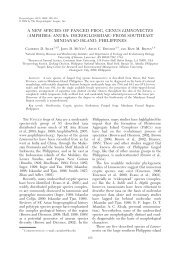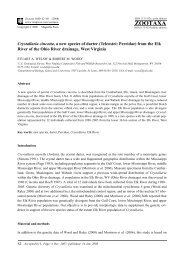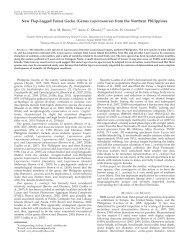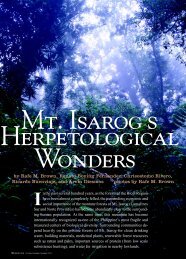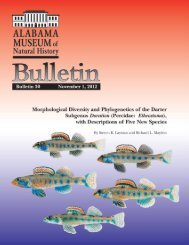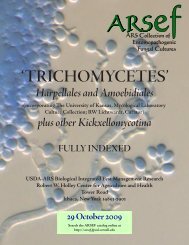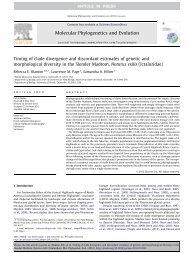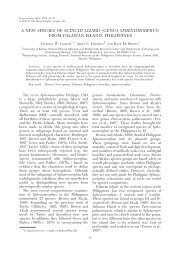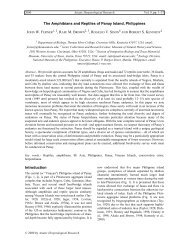Rhodactis - Natural History Museum
Rhodactis - Natural History Museum
Rhodactis - Natural History Museum
Create successful ePaper yourself
Turn your PDF publications into a flip-book with our unique Google optimized e-Paper software.
Corallimorpharians of Oman,<br />
with discussion of the generic<br />
circumscription of <strong>Rhodactis</strong><br />
Ha-Rim Cha<br />
Division of Invertebrate Zoology<br />
KU <strong>Natural</strong> <strong>History</strong> <strong>Museum</strong> and<br />
Biodiversity Research Center<br />
Harim anemone Kirkendale, 2004
Corallimorpharians of Oman,<br />
with discussion of the generic<br />
circumscription of <strong>Rhodactis</strong><br />
Ha-Rim Cha<br />
Division of Invertebrate Zoology<br />
KU <strong>Natural</strong> <strong>History</strong> <strong>Museum</strong> and<br />
Biodiversity Research Center
Cnidaria: Anthozoa: Hexacorallia<br />
Actiniaria<br />
Corallimorpharia<br />
Scleractinia<br />
Zoanthidea<br />
Ceriantharia<br />
Antipatharia
Corallimorpharia<br />
• Cnidaria<br />
– 2 layered, organ-less body, with<br />
stinging nematocysts<br />
• Anthozoa<br />
– Polyp form only in life cycle<br />
• Corallimorpharia<br />
– Skeleton-less, solitary or clonal<br />
(not colonial)
Why study corallimorpharians<br />
• Diverse in habitat,<br />
biology, life history<br />
• Relatively unknown<br />
• Understand evolution of<br />
colonies and skeletons<br />
among Anthozoa
Habitat<br />
• Attached to rocks or<br />
coral skeletons<br />
• Tropical to polar areas<br />
• Intertidal to deep sea
Shallow tropical<br />
• Family<br />
Discosomatidae<br />
• Family<br />
Ricordeidae<br />
1 cm<br />
1 cm<br />
10 cm<br />
Dunn D. F. and Hamner W. M.,<br />
1980, Page 30 , fig. 1
Shallow<br />
tropical and temperate<br />
• Family Corallimorphidae<br />
Genus Corynactis<br />
Genus Pseudocorynactis<br />
1cm
Deep water<br />
• Family Corallimorphidae<br />
Genus Corallimorphus<br />
• Family Sideractiidae<br />
Moseley H.<br />
N., 1877,<br />
Plate XLV ,<br />
fig. 7<br />
Zamponi M. O., 1976, Page 131 , fig. 1
How can we interpret and<br />
understand this diversity<br />
TAXONOMY and SYSTEMATICS
What is it<br />
Process of identification<br />
• Find specimen<br />
• Compare multiple specimens<br />
• Develop sense of range of<br />
variation in color & morphology
Is it the same<br />
Process of comparison<br />
• Color, size, shape, behavior<br />
& habitat<br />
• Arrangement and<br />
morphology of mesenteries<br />
& muscles<br />
• Size, shape & distribution of<br />
nematocysts
Oman<br />
• May 7 ~ 30, 2004<br />
• Survey of Actiniaria and Corallimorpharia<br />
in Oman<br />
• Participants: Meg Daly, Adorian Ardelean<br />
and Ha-Rim Cha<br />
• Collaborator: Dr. Michel Claereboudt,<br />
Department of Marine Science and<br />
Fisheries, Sultan Qaboos University<br />
(SQU), Muscat, Oman
The Gulf of Oman<br />
• The area is strongly<br />
influenced by seasonal<br />
monsoon cycles associated<br />
with upwelling and algal<br />
blooms<br />
• The coast of Oman includes<br />
three distinct habitats: muddy<br />
and sandy shores, rocky<br />
shores, and coral<br />
communities (Coles 1996)
Distribution of Corallimorpharia
Oman
Underwater Oman
Underwater Oman
Diversity in Oman<br />
• 12 species of actiniarians<br />
• 3 species of corallimorpharians<br />
Edwardsiidae n. sp.1 Edwardsiidae n. sp.2 Discosoma n. sp.
Actiniarians in Oman<br />
• ● Components of the tropical Indo-<br />
Pacific fauna<br />
• New species<br />
(possibly endemic)<br />
• Lacking<br />
representatives<br />
of Acontiaria
Corallimorpharians of Oman<br />
Genus Discosoma
Corallimorpharians of Oman<br />
Genus <strong>Rhodactis</strong><br />
<strong>Rhodactis</strong> rhodostoma
Family Discosomatidae<br />
<strong>Rhodactis</strong> Milne Edwards and Haime, 1851<br />
• Problem 1<br />
The original description of the type species<br />
of <strong>Rhodactis</strong> (Metridium rhodostomum<br />
Hemprich and Ehrenberg in Ehrenberg,<br />
1834) contains few diagnostic characters.<br />
• Problem 2<br />
Most generic characters are not consistently<br />
used among authors.
What are the characters of<br />
<strong>Rhodactis</strong> rhodostoma (Hemprich and<br />
Ehrenberg in Ehrenberg, 1834) <br />
• Type specimens: no longer extant<br />
• Type locality: Tor, the Red Sea<br />
• Material examined: Oman -- KUNHM<br />
002077 (x3), KUNHM 002093 (x5)
What are the characters of<br />
<strong>Rhodactis</strong> rhodostoma (Hemprich and<br />
Ehrenberg in Ehrenberg, 1834) <br />
• Column: short, smooth, mesenterial<br />
insertions visible<br />
• Oral disc: densely covered with tentacles.<br />
30~50 mm diameter in life, preserved<br />
specimens 15~25 mm. No tentacle-free<br />
zone.<br />
• Pedal disc: about half as wide as oral disc<br />
• Color: greenish purple to purple
What are the characters of<br />
<strong>Rhodactis</strong> rhodostoma (Hemprich and<br />
Ehrenberg in Ehrenberg, 1834) <br />
• Tentacle: Two kinds of tentacles; digitate and<br />
branched. No distinction between marginal and<br />
discal tentacles. Peripheral tentacles and those<br />
around the mouth digitate; most intermediate<br />
tentacles branched. In life to 5 mm long.
What are the characters of<br />
<strong>Rhodactis</strong> rhodostoma (Hemprich and<br />
Ehrenberg in Ehrenberg, 1834) <br />
• Nematocyst size and distribution<br />
• Musculature: no sphincter muscle; weak<br />
retractor muscles<br />
• Habitat: live in patches on dead coral or rocks;<br />
3~10 m deep<br />
• Behavior: Feeding by envelopment. Mesenterial<br />
filaments extruded when disturbed<br />
• Symbionts: zooxanthellae (size 8~9.5 µm in<br />
diameter)
Characters of <strong>Rhodactis</strong> based on<br />
the examination of type species<br />
Nature of tentacles: DIGITATE and BRANCHED tentacles<br />
Distinction between marginal and discal tentacles: NONE<br />
Tentacle-free zone on oral disc: NO<br />
Nematocyst composition:<br />
holotrichs (large and small), microbasic p-<br />
mastigophores, microbasic b-mastigophores<br />
Sphincter muscle: NO<br />
Behavior: Feeding by ENVELOPMENT<br />
Symbionts: YES
Species composition<br />
Before<br />
After<br />
<strong>Rhodactis</strong> bryoides<br />
R. howesii<br />
R. inchoata<br />
R. indosinensis<br />
R. musciformis<br />
R. rhodostoma<br />
<br />
R. mussoides
Revise the family Discosomatidae<br />
• Family Discosomatidae<br />
Genus <strong>Rhodactis</strong><br />
Discosoma<br />
Paradiscosoma<br />
Metarhodactis<br />
Actinotryx<br />
Orinia<br />
Phialactis<br />
Amplexidiscus
Caribbean
Trip to St. Thomas,<br />
US Virgin Islands
Purposes of the trip<br />
• Survey of corallimorpharians of St.<br />
Thomas<br />
• Revision of corallimorpharian genera<br />
described from the Virgin Islands
Species sanctithomae<br />
• Type specimens: no longer exist<br />
• Type locality: St. Thomas, Virgin Islands<br />
• Where does this species belong<br />
Genus Actinotryx<br />
Genus Orinia<br />
Genus Discosoma<br />
Genus <strong>Rhodactis</strong>
Collecting Sites
What I saw<br />
in St. Thomas…
Corallimorpharians<br />
collected from St. Thomas<br />
Discosoma sp.<br />
Ricordea florida
Corallimorpharians<br />
collected from St. Thomas<br />
Duchassaing de Fonbressin P. and<br />
Michelotti G., 1860, Plate VII , fig. 2<br />
sanctithomae
Future directions<br />
• Gathering data from<br />
type specimens of<br />
species of genera<br />
in family<br />
Discosomatidae<br />
• Molecular data will be<br />
added for the genus<br />
and order level<br />
phylogenies<br />
Corallimorpharia I<br />
Corallimorpharia II<br />
Scleractinia<br />
Actiniaria<br />
Ceriantharia
Acknowledgments<br />
• Michel Clareboudt, staff & faculty of<br />
Marine Sciences, SQU<br />
• Dr. Daphne Fautin (KU)<br />
Dr. Meg Daly (OSU)<br />
Dr. Adorian Ardelean (West<br />
University of Timisoara, Romania)<br />
Matthew Kost (KU)<br />
• American Association for the<br />
Advancement of Science, National<br />
Science Foundation, KU <strong>Natural</strong> <strong>History</strong><br />
<strong>Museum</strong> & Biodiversity Research Center



